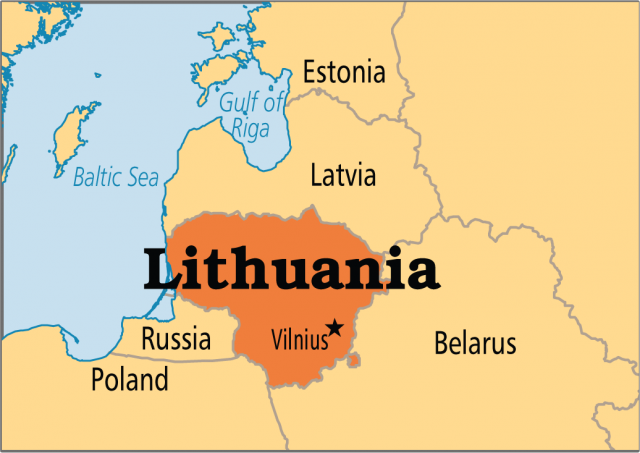Lithuania
Area 25,173 square mi (65,200 square km)
Population 2.929 million 2014
Capital Vilnius
Highest Point Juozapine/Kalnas 954 ft (292 m)
Lowest Point 0 m
GDP $48.17 billion 2014
Primary Natural Resources peat, arable land.
THE REPUBLIC OF Lithuania in northern Europe is a lowland country that borders LATVIA to the north, BELARUS to the east and southeast, POLAND and the Russian enclave of Kaliningrad to the southwest, and the Baltic Sea to the west. Lithuania is a parliamentary democracy with the supreme council or Seimas serving as the legislature and the president serving as head of state. Its major cities are Vilnius, Kaunas, and Klaipedia.

The Lithuanian countryside consists of lowlands and small hills and is dotted by 3,000 lakes. The climate is generally humid, with peak rainfall in August. Temperatures range from 23 degrees F (-5 degrees C) in January to 63 degrees F (17 degrees C) in June. The chief river is the Nemunas, which flows to the Baltic Sea.
Permanent human settlements in what is now Lithuania date to about 8000 B.C.E. In the 13th century, the Teutonic Knights were sent to Lithuania to convert the pagan population to Christianity. In 1385, Grand Duke Jogaila married Queen Jadwiga of POLAND, which began the Christianization of Lithuania and its special relationship with Poland. In 1569, the Treaty of Lublin joined the Grand Duchy of Lithuania and the Kingdom of Poland into a Polish-Lithuanian Commonwealth to balance the growing power of Moscow. Thereafter, Lithuania joined Poland's decline, ultimately culminating in the partitions by AUSTRIA, Prussia, and RUSSIA between 1772 and 1795.
Lithuania was incorporated into the Russian Empire after the final Polish partition in 1795. The population was subjected to harsh policies forbidding use of the Lithuanian language, resulting in revolts in 1830 and 1863. In 1918, Lithuania declared its independence amid the destruction and chaos of World War I and the Russian Revolution. In August 1939, the Molotov-Ribbentrop Pact split Poland and the Baltic States between the Soviet Union and Nazi Germany. In 1941, the Nazis invaded Lithuania, only to be reoccupied by the Soviet Union. After World War II, Lithuania was incorporated into the Union of Soviet Socialist Republics.
In 1991, Lithuania regained its independence with the other Baltic States. The last Soviet troops withdrew from Lithuanian soil in 1993. Like its Baltic neighbors, Lithuania has taken steps to integrate into Europe by joining the NORTH ATLANTIC TREATY ORGANIZATION (NATO) in 2003 and the EUROPEAN UNION in 2004.
Lithuanians make up 80 percent of the population, with the remainder consisting of Russians, Poles, and Belarussians. Roman Catholicism is the religion practiced by the majority of Lithuanians. After the demise of the Soviet Union, the state of Russians residing since the Soviet era poses a challenge for Lithuania.
The Lithuanian economy has had to transform from a command economy under the control of Moscow to a free market economy. This process has been successful in bringing prosperity but has also created inequities in the standard of living. Lithuania's chief exports are meat, milk, dairy products, and television parts, while remaining dependent on oil and natural gas from Russia.